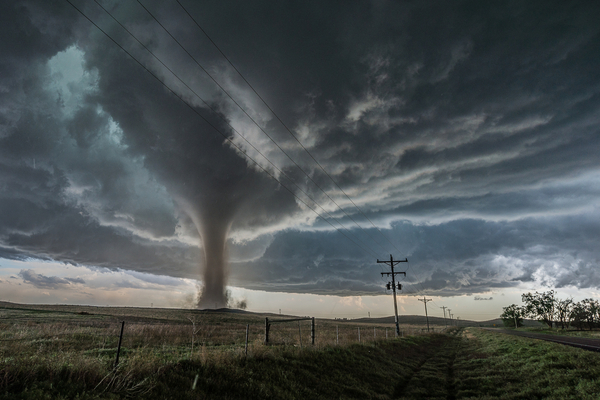With tornado season in full-swing, it’s worthwhile to look back at the United States’ impressive tornado history. According to the NOAA, the U.S. averages over 1,000 tornadoes a year, far more than any other country in the world. Some of those tornadoes can be exceedingly deadly and destructive, hitting a 4 or 5 on the Enhanced Fujita (EF) scale.
While the area in the Central U.S. known as “tornado alley” is infamous for its disproportionate share of these more intense tornadoes, they can show up anywhere, especially in “Dixie Alley,” an area in the Southeast part of the country. Here’s a look at a handful of tornadoes that made the record books over the last century.
The deadliest: The Tristate Tornado, March 8th, 1925
The Tristate Tornado hit on March 18th, 1925 and traveled across three states — Missouri, Illinois and Indiana. Based on the damage it caused, it was determined to be an EF 5 after the fact because the EF scale wasn’t in use at the time. The tornado was approximately .75 miles wide and traveled a staggering 219 (newer research suggests it had a continual path of at least 174 miles) at a 59 mph pace. It caused 695 fatalities and destroyed over 15,000 homes. The lack of tornado watches and warnings in 1925 was likely a major contributor to the inconceivable destruction.
The costliest: Joplin, Missouri on May 22nd, 2011
Occurring just one month after a record-breaking tornado outbreak in the South, this EF 5 tornado tore through the city of Joplin, leaving a $2.8 billion damage bill in its wake. 7,500 residences, 500 businesses and over 15,000 vehicles were impacted. It contorted St. John’s Mercy hospital to such an extent that the building need to be demolished. It just goes to show that while tornadoes don’t often hit heavily populated areas, when they do, it can result in catastrophic levels of destruction.
Highest average number of annual tornadoes: Texas
According to the NOAA, between 1991 and 2010, Texas saw the highest average number of tornadoes in a year (155). Kansas was a close second with 96.
Largest and most expensive tornado outbreak: April 25-28, 2011 super outbreak
The April 2011 super outbreak is considered one of the worst tornado outbreaks in U.S. history. Over four days, almost 350 tornadoes cropped up across a wide span of states, from Texas all the way up to New York. Several of these tornadoes were rated EF 4s and 5s, and caused significant amounts of damage. Overall, the amount of storms coupled with the expansive area the outbreak covered resulted in over $12 billion in damages making it the costliest tornado outbreak in U.S. history.
Most tornadoes in a month: April, 2011
As a result of the 2011 super outbreak April, 2011 was declared the month with the most reported tornadoes on record. Second place is May, 2003 with 542. Typically, April, May and June have the most tornado activity with May seeing the most.
Longest path of a tornado: Tristate Tornado
The 1925 Tristate Tornado again takes first place here with its 219 mile (174 continuous mile) path across 3 states. And at a 59mph clip, it was able to travel this distance in just 3 and a half hours.
Widest tornado: El Reno, Oklahoma, May 31st, 2013
Tornadoes that are over 1 mile wide are rare, and over 2 miles wide are almost unfathomable. The one that hit El Reno, Oklahoma in 2013 was 2.6 miles wide. Wide tornadoes aren’t always the most deadly, but the El Reno, Oklahoma was an exception. It was initially rated an EF 3, but experts believe the lower rating was likely due to its less intense observed damage field since it was traversing mainly rural areas. Even so, it’s wind speed was estimated to have topped out at almost 300 mph.
Tornado with the strongest winds: Oklahoma City, May 3rd, 1999
Throughout history, wind speeds have only been recorded in a small percentage of tornadoes, so it’s impossible to definitively say this tornado had the strongest winds. However, out of those that have recorded wind speeds, this EF4/EF5 that pummeled Oklahmona City takes first place at 318 mph.
Since it hit a heavily populated area, this large tornado did a lot of damage. It also claimed the lives of 36 people.
Largest pressure drop in a tornado: Manchester, South Dakota, June 24th, 2003
When a major storm like a tornado or hurricane is imminent, a sizable barometric pressure drop is usually noted. The largest one ever recorded happened right before an EF4 leveled the small town of Manchester on June 4th, 2003. A nearby probe measured a pressure deficit of 100 millibars.
—
Photo Credit: Cammie Czuchnicki / Shutterstock.com
